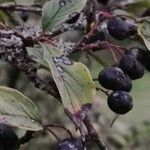Shrubs deciduous, 2–4 m tall. Branchlets brownish or reddish brown, terete, slender, initially villous, glabrescent. Petiole 2–5(–10) mm, villous; stipules caducous, brown, linear-lanceolate, 3–5 mm, slightly villous; leaf blade elliptic-ovate to oblong-ovate, 2–4(–5) × 1–2(–3) cm, veins raised abaxially and impressed adaxially, adaxially glabrous or both surfaces initially villous, gradually glabrescent, subglabrous when old, base broadly cuneate, apex acute, rarely acuminate. Corymbs 2–4 cm, 2–5-flowered; rachis and pedicels villous; bracts linear-lanceolate, 3–5 mm, slightly pilose. Pedicel 3–5 mm. Flowers 7–8 mm in diam. Hypanthium campanulate or shortly cylindric, abaxially glabrous or villous. Sepals triangular, 1–2 × 1.5–2 mm, apex acute or ± obtuse. Petals erect, white, tinged reddish, broadly obovate or oblong, 3.5–4.5 × 3–4 mm, glabrous, base somewhat long clawed, apex obtuse. Stamens 10–15, shorter than petals. Ovary densely villous apically; styles often 2, free, not exceeding stamens. Fruit black, ellipsoid, obovoid, or subglobose, 6–8(–10) mm in diam., villous, pyrenes 2 or 3. Fl. May–Jun, fr. Aug–Sep.
More
A shrub. It loses its leaves during the year. It grows 4 m high. The branches are slender and spreading. The plant is hairy. The leaves are narrowly oval or rounded. They are 2-5 cm long by 1-4 cm wide. The base is broadly wedge shaped. They are dull green above and paler underneath. The flowers are pink. They occur as 2-5 together at the ends of the plant on the current year's growth. The fruit is oval and 7-9 mm long and purple-black at maturity.
It is a temperate plant. It grows in northern China. It grows on hillsides between 1,000-3,700 m above sea level. In Sichuan and Yunnan.



